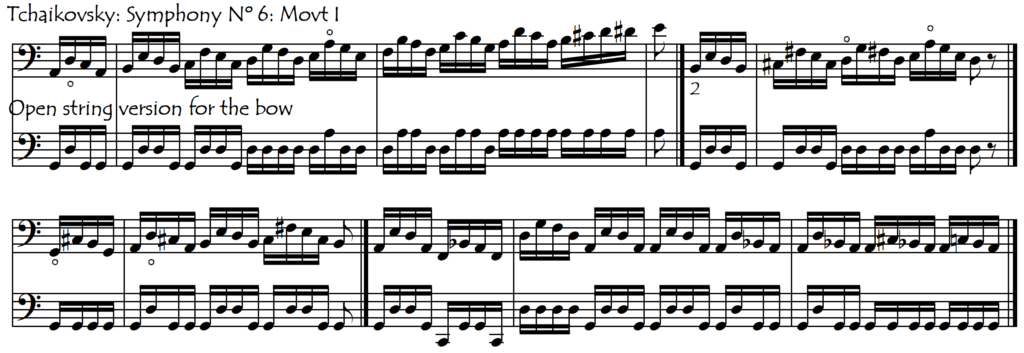Fast Playing: Exercises and Repertoire Compilations
There are so many fast passages in the repertoire to choose from and use as practice material. I hope to have time one day to make some proper compilations, which could be organised into some basic categories (outlined below) following an increasing order of difficulty. Of course, most “fast passages” (or any repertoire excerpts, in fact) don’t fit neatly into any one category which is why these categories have very loose boundaries. For “pure” examples of the different types of fast-playing problems in isolation, see the pages “Fast/Tricky Passages” and “Tips For Practicing Fast/Tricky Bits“.
1: PURE, SIMPLE, FAST FINGER ARTICULATIONS IN ONE POSITION ON ONE STRING UNDER A SLUR:
The simplest, easiest note changes are those that occur between notes in the same position and on the same string under a slur (in other words, without the need to coordinate the finger change with a bow change). Of these, the easiest figures are those in which our fingers follow each other consecutively, allowing our hand to “roll” in the direction of the finger sequences. We can actually play all of these little exercises (finger sequences) without the cello, simply drumming our fingers on any surface (arm, table, bench etc), respecting the extended and non-extended finger spacings. We can experiment with playing these patterns (on the cello or on any surface) with and without this “hand roll”, to see how the rolling movement helps the finger articulations but also helps to keep the hand loose and flexible. In thumbposition, the thumb acts as an anchor and the hand will tend to roll much less than when the thumb is off the fingerboard. Initially, we will play everything with long slurs in order to concentrate on the lefthand.
Fast: Hand In One Position On One String: EXERCISES WITH HAND ROLL
Fast: Hand In One Position On One String: REPERTOIRE EXCERPTS
1. A: FAST FINGER ARTICULATIONS IN ONE POSITION WITH BOW CHANGES
To add coordination difficulty between the two hands, we can play the above exercises with shorter slurs and then ultimately eliminate all slurs, which brings us to a maximum degree of lefthand/righthand coordination difficulty. Rather than playing one note per bow (changing the finger with every bowchange), probably the best way to work on the skill of coordinating fast lefthand finger articulations and releases with the bowchanges is using several bow strokes (fast) on each note. In this way, even though each finger placement/release is fast, during those additional bowstrokes on the same note our brain has time to recover, observe and prepare for the next LH movement.
The more bowchanges we put on each pitch, the easier our task becomes but we probably don’t need to do any more than four bowstrokes per note as a maximum. Three bows per note introduces the complication of the upbow on the beat while two bows per note is our last stop before we get to the maximum coordination speed of one bow per note. At their most simple, we can do these exercises for any pair of fingers (start also on the higher finger) but we can also practice any fast or tricky passage using the same principle:

2: FAST FINGER ARTICULATION WITH SMALL SHIFTS ON THE SAME STRING
Now, we will add shifting (only small shifts) but still stay on the same string. Once again, we will play everything initially with long slurs in order to concentrate on the lefthand. Then we can make our slurs shorter and ultimately eliminate all slurs, which brings us to a maximum degree of lefthand/righthand coordination difficulty.
Fast Finger Articulation With Small Shifts On The Same String: REPERTOIRE EXCERPTS
3: FAST FINGER ARTICULATION IN ONE POSITION WITH SOME SIMPLE STRING CROSSINGS TO NEIGHBOURING STRINGS
In these types of passages not only are we working on our fast finger articulations and releases but also on their rapid horizontal displacements across the strings. With the addition of fast string crossings, life becomes much harder for the bowarm now also, especially if, as in the above example, the string crossings are frequent. We would be well advised, in these cases, to practice the string crossings on their own, with only the open strings. See also the pages dedicated to the subject of String Crossings.

4: SCALIC PASSAGES ACROSS STRINGS WITH SHIFTS AND STRETCHES
Here, we are looking at passages in which the string crossings are well separated from each other
Scalic Passages Across Strings With Shifts And Stretches: REPERTOIRE EXCERPTS

1.5 NON-SCALIC PASSAGES ACROSS STRINGS WITH SHIFTS AND STRETCHES
Here, because the passages are non-scalic, we are looking at passages with more frequent string crossings and shifts.
Non-Scalic Passages Across Strings With Shifts And Stretches: REPERTOIRE EXCERPTS
FAST BOW (WITH LESS LEFTHAND DIFFICULTIES)
Sequences of fast bowchanges on the same string and with occasional string crossings are included in all the fast lefthand examples when they are played with separate bows. Fast passages with a lot of string crossings, however – both separate and slurred – are looked at in the String Crossing section.
